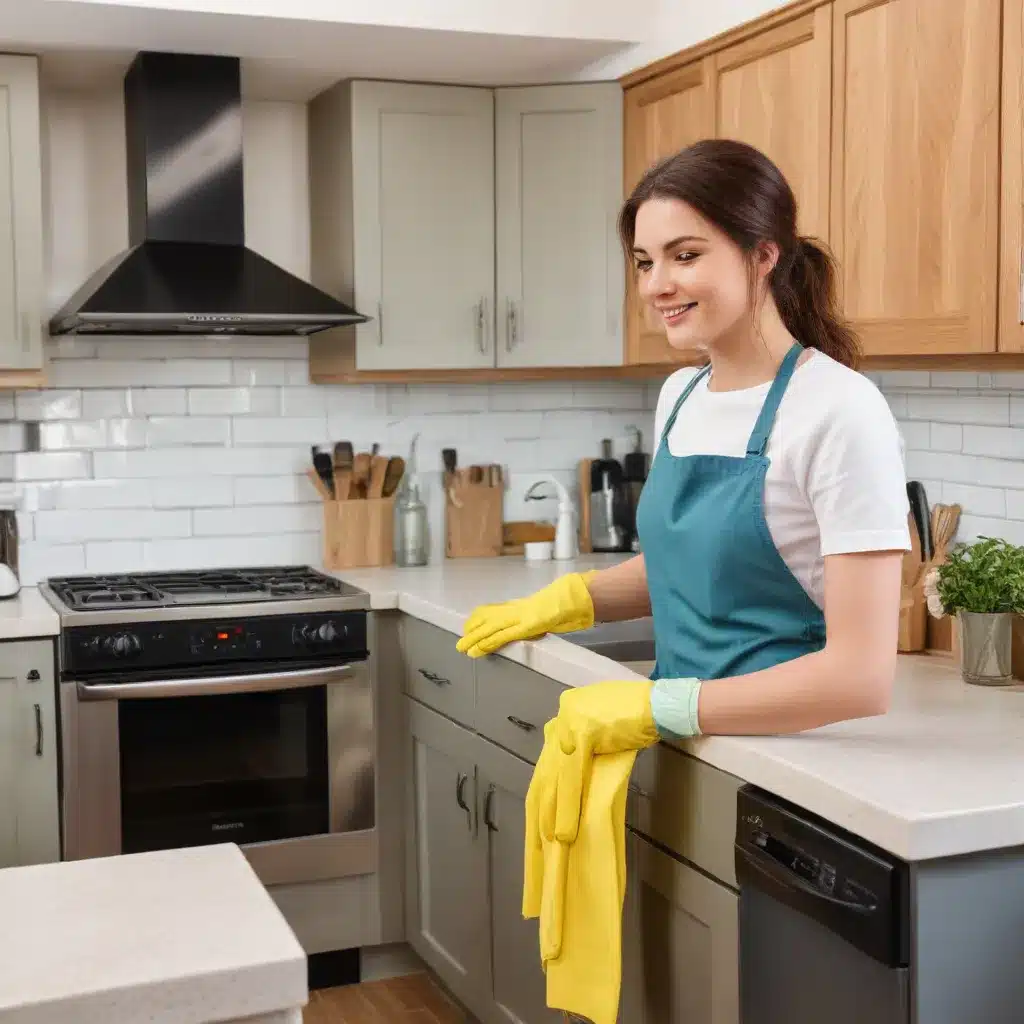
As a seasoned culinary professional, I understand the importance of maintaining a clean and hygienic kitchen. Not only does a spotless workspace ensure the safety of your food, but it also promotes a sense of order and efficiency in the heart of your home. In this comprehensive guide, I’ll walk you through a step-by-step process to deep clean and disinfect your kitchen, empowering you to create a healthy and harmonious cooking environment.
Gather Your Supplies
Before you begin, it’s essential to have the right tools and cleaning solutions at your fingertips. Assemble the following items:
- Warm, soapy water
- Disinfecting spray or solution (a homemade bleach-based solution or a commercial sanitizer)
- Clean microfiber cloths or paper towels
- Scrub brush or sponge
- Vacuum cleaner with attachments
- Mop and bucket
- Rubber gloves (optional)
Having these items readily available will ensure a smooth and efficient cleaning process.
Step 1: Clear the Clutter
Start by removing all items from your countertops, shelves, and surfaces. This includes small appliances, utensils, and any other objects that may be in your way. Gather these items in a designated area, where you can clean and sanitize them individually.
Step 2: Dust and Wipe Down Surfaces
Begin by dusting all surfaces, including cabinets, shelves, and windowsills. Use a microfiber cloth or a damp paper towel to gently remove any accumulated dust or debris. Pay special attention to hard-to-reach areas, such as the tops of cabinets and behind appliances.
Next, use your warm, soapy water solution to wipe down all countertops, tables, and other flat surfaces. Be sure to scrub away any visible dirt, grease, or stains. Rinse the surfaces with a clean cloth or paper towel, ensuring they are free of any soap residue.
Step 3: Clean and Sanitize the Sink
The kitchen sink is a breeding ground for bacteria, as it often comes into contact with raw meats, poultry, and other potentially hazardous foods. Start by giving the sink a thorough cleaning with your soapy water solution. Scrub the basin, faucet, and drain with a scrub brush or sponge to remove any grime or buildup.
Once the sink is visibly clean, it’s time to sanitize. Prepare your disinfecting solution, either a homemade bleach-based mixture or a commercial sanitizer, and apply it liberally to all surfaces of the sink. Allow the solution to sit for the recommended time, typically 5-10 minutes, before rinsing it away with clean water.
Step 4: Clean and Sanitize Appliances
Your kitchen appliances, such as the oven, stovetop, and microwave, can accumulate significant amounts of grease, food particles, and other contaminants. Begin by unplugging the appliances and removing any removable parts, such as oven racks or microwave turntables. Soak these parts in warm, soapy water to loosen any stubborn grime.
For the exterior surfaces, use a damp cloth or sponge and your soapy water solution to wipe down the appliances. Pay close attention to corners, crevices, and control panels, as these areas are prone to buildup.
Once the appliances are visibly clean, apply your disinfecting solution and allow it to sit for the recommended time before wiping it away with a clean cloth or paper towel.
Step 5: Tackle the Floors
No kitchen cleaning routine is complete without addressing the floors. Start by thoroughly vacuuming the entire kitchen, using the appropriate attachments to reach corners, baseboards, and under appliances.
Next, fill a mop bucket with warm water and add a few drops of your preferred floor cleaner. Mop the floors, working in sections and rinsing the mop head frequently to avoid spreading dirt and debris. Be sure to pay special attention to high-traffic areas and around the edges of the room.
For an extra level of cleanliness, you can disinfect the floors by spraying or mopping a diluted bleach solution (1 tablespoon of bleach per gallon of water) or a commercial floor disinfectant. Allow the solution to sit for the recommended time before rinsing the floors with clean water.
Step 6: Clean and Sanitize Utensils and Cutting Boards
Your cooking tools and cutting surfaces are essential for food preparation, so it’s crucial to keep them clean and sanitized. Start by washing all utensils, pots, pans, and dishes in warm, soapy water. Scrub away any visible food particles or grease, and be sure to wash both the inside and outside of each item.
If you have dishwasher-safe items, you can run them through a full cycle to ensure they are thoroughly cleaned and sanitized. For items that cannot be placed in the dishwasher, such as wooden cutting boards, immerse them in your disinfecting solution for the recommended time before rinsing and air-drying.
Step 7: Maintain and Repeat
Maintaining a clean and disinfected kitchen requires ongoing effort. Establish a regular cleaning schedule, such as a daily wipe-down of surfaces and a more thorough deep cleaning once a week or month, depending on the level of use and activity in your kitchen.
Remember to wash kitchen towels, dishcloths, and other textile items frequently in the hot cycle of your washing machine to prevent the buildup of bacteria. Additionally, be mindful of expiration dates on food items and promptly discard any spoiled or contaminated products.
By following this step-by-step guide, you’ll be well on your way to creating a clean, sanitized, and safe kitchen environment. Not only will this help prevent the spread of foodborne illnesses, but it will also foster a sense of order and cleanliness that can inspire your culinary creativity. Happy cooking!


